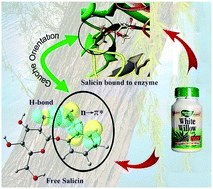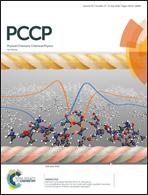Interplay between hydrogen bonding and n→π* interaction in an analgesic drug salicin†
Abstract
The competition and cooperation between weak intermolecular interactions are important in determining the conformational preferences of molecules. Understanding the relative strengths of these effects in the context of potential drug candidates is therefore essential. We use a combination of gas-phase spectroscopy and quantum-chemical calculations to elucidate the nature of such interactions for the analgesic salicin [2-(hydroxymethyl)phenyl β-D-glucopyranoside], an analog of aspirin found in willow bark. Of several possible conformers, only three are observed experimentally, and these are found to correspond with the three lowest energy conformers obtained from density functional theory calculations and simulated Franck–Condon spectra. Natural bond orbital analyses show that these are characterized by a subtle interplay between weak n→π* interaction and conventional strong hydrogen bond, with additional insights into this interaction provided by analysis of quantum theory of atoms in molecules and symmetry-adapted perturbation theory calculations. In contrast, the higher energy conformers, which are not observed experimentally, are mostly stabilized by the hydrogen bond with negligible contribution of n→π* interaction. The n→π* interaction results in a preference for the benzyl alcohol group of salicin to adopt a gauche conformation, a characteristic also found when salicin is bound to the β-glucosidase enzyme. As such, understanding the interplay between these weak interactions has significance in the rationalization of protein structures.

- This article is part of the themed collection: 1st International Conference on Noncovalent Interactions


 Please wait while we load your content...
Please wait while we load your content...